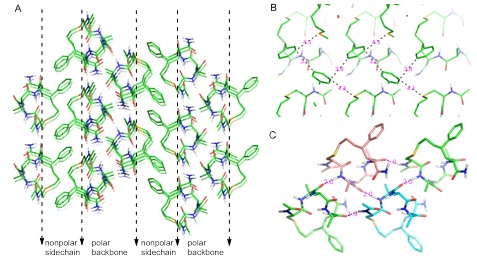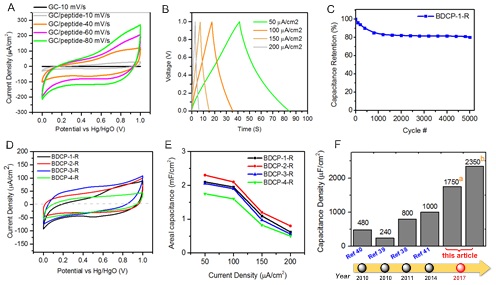Recently, the Li Zhou Group of the Beijing Institute of Nano Energy and Systems, Chinese Academy of Sciences in collaboration with the Li Zigang Research Group and the Wang Xinwei Research Group of the Graduate School of Shenzhen University of Peking University, applied the new model of α-helix polypeptide self-assembly and its application in energy storage. New progress was made in the research and related research results were published in the recent Science Advances of Science (DOI: 10.1126/sciadv.aar5907).
Accurate hierarchical self-assembly of polypeptide molecules as a method of bottom-up preparation of bio-nano-micro materials, which has been subjected to biomimetics, catalysis, material separation, and bioelectronic devices. The more attention is paid to it. Compared with inorganic nanomaterials, polypeptide molecules have a wide range of sources, are naturally degradable, have good biocompatibility, and are easy to modify. Characterized by FF (F: phenylalanine) dipeptides and their derivatives, through a series of physics (electric field assisted method, magnetic field assisted method, temperature assisted method, ultrasonic assisted method) and chemistry (pH, solvent method, catalytic method ) Means to precisely manipulate the pathway of peptide molecule self-assembly. A series of nano-polypeptide materials with special structures, such as polypeptide nanotube nanofibers, nanowires, nanogels, and nanometer quantum dots, have been obtained. These materials have good semiconductor properties. , Or exhibit superior flexibility and special optical properties. It has been widely used in fields such as flexible supercapacitors/batteries, piezoelectric devices, biosensors, photoconductive devices, and biomedical applications.
Self-assembly of polypeptide molecules is achieved by adjusting the non-covalent interaction between polypeptide molecules, such as van der Waals forces, hydrogen bonding networks, hydrophobic interactions, π-π interactions, etc., to achieve long-range ordering of polypeptide molecules under certain conditions. means. Due to the complex and diverse molecular structure of polypeptides, changes in the sequence of polypeptides result in molecularly distinct properties. Therefore, it is very difficult to predict and design the self-assembly of polypeptide molecules. In the early years, studies on polypeptide self-assembly mainly focused on amphipathic polypeptide molecules, β-sheet polypeptides, end-to-end linked cyclic DLD polypeptide molecules, and FF dipeptide molecules. For more complex spiral polypeptide self-assembly, few reports. The reason is that the entropy value of the helix polypeptide is low, and the hydrogen bond network is blocked inside the polypeptide and it is difficult to form a hydrogen bond network between the molecules. Therefore, how to manipulate polypeptides with more complex secondary structures, such as helical polypeptides, to achieve controlled self-assembly is one of the most difficult points in current research.
Li Zhou's research group has long paid attention to and published a series of preparation and application of implantable devices based on biodegradable molecules. In view of the great prospect of polypeptide molecules in this field, the research group conducted research on the storage and energy sensing of peptide nanomaterials, and published relevant papers in the international academic journal Small. Recently, Li Zhou's research group and its collaborators have developed a novel method for preparing peptide nanomaterials based on a chiral helix-inducing system. Based on this system, the researchers believe that the driving force-side loop interaction outside the main chain can be used to compensate for the shortcomings of the lack of driving force for the self-assembly of the helical polypeptide backbone, and to realize a novel mode of peptide assembly method, the so-called The "side loop driven" polypeptide self-assembles. Based on such an idea, the researchers carried out detailed screening and characterization. Using pentapeptide as a model, they designed and synthesized a series of pentapeptide molecules with chiral side rings, named BDCP. The results show that when the BDCP is a helix structure and the side ring substituents are aromatic, the peptide molecules can be assembled into nanotube/nanoribbon structures.
Next they studied the mechanism of polypeptide self-assembly. By cooperating with two research groups of Peking University Shenzhen Graduate School, the crystal structure of the peptide assembly structure was predicted, and an assembly model of polypeptide molecules was obtained. The model shows good agreement with the experimental results. The results showed that the π-π interaction, the S-π interaction, and the hydrogen bonding network between polypeptide molecules drove the assembly of polypeptide molecules. In the polypeptide assembly, the polar and non-polar interfaces are sequentially formed, and the dipoles in each of the two polar layers are opposite in direction, so that the dipole interactions inside the assembly cancel each other, further stabilizing the assembly. This is also the first report in this field that the S-π interaction is involved in the self-assembly of polypeptides.
On this basis, the researchers further studied the optical and electrical properties of the assembled materials. Under different excitation light irradiation, the polypeptide assembly can emit from blue to red fluorescence. The material has a huge application prospect in the field of bioimaging. In the electrical test, under the guidance of Li Zhou, the researchers explored the energy storage properties of peptide assemblies as supercapacitor active materials. In 2009, scientists from Israel reported for the first time the use of cyclic phenylalanine dipeptide "nano-forest" materials in energy storage. This study shows that peptide materials have good mechanical and electrical properties, combined with the high specific surface area of ​​polypeptide nanomaterials, suitable hydrophilicity and hydrophobicity, and excellent conductive properties, and peptide energy storage has become the next generation of flexible, implantable, Potential options for lightweight, non-polluting energy storage devices. In this study, the researchers systematically compared the electrochemical properties of the four groups of polypeptide molecules and the results showed that the energy storage of the polypeptide material can be regulated by the polypeptide sequence. Cyclic voltammetry, galvanostatic charge-discharge and other electrochemical measurement methods have proved that the peptide material has good cycle stability, rateability, and higher specific capacitance than FF polypeptide material.
This study not only has important theoretical value in the preparation of polypeptide materials, but also has important application prospects. Hu Kuan, assistant researcher of the Li Zhou Group, was the co-first author of the dissertation. Ph.D. student Li Hu made a contribution to electrochemical testing. Based on the above work, Li Zhou's research group is currently actively carrying out research work on peptide energy storage and polypeptide piezoelectric sensing.

SEM photographs of the structure and assembly of polypeptide molecules

Molecular Structure Prediction of Peptide Assemblies

Electrochemical properties of polypeptide assemblies
Ultra Plantâ„¢ Grow Light offers One Chip Technology aimed to meet your indoor growing expectation such as improve plants' quality, increase yield, or better the margin, etc., all for helping you realize a higher return on your crops.
Ultra Plantâ„¢ Grow Light is combined our advanced All-In-One technology with patented optical design and customized light full spectrum supported from our experienced LED engineers, plant specialists and other partners working on horticulture.
From Ultra Plantâ„¢ APP, you are able to schedule the growing process including photoperiod, brightness and spectral in advance. The lighting system will help you grow smarter, easier and better.
Ultra Plantâ„¢ is the most versatile horticultural grow lighting fixture for indoor plants with flexible full spectrum, brightness control and uniform, wider light distribution, suitable for top lighting of all types of crops. No matter it applies to anywhere for any crop, Ultra Plantâ„¢ can do perfect work for you.
Grow Light On Flowering,Flowering Grow Lights,Red Light For Flowering,Led Grow Light For Veg And Flower
Feton Corporation , https://www.fetongrowlight.com